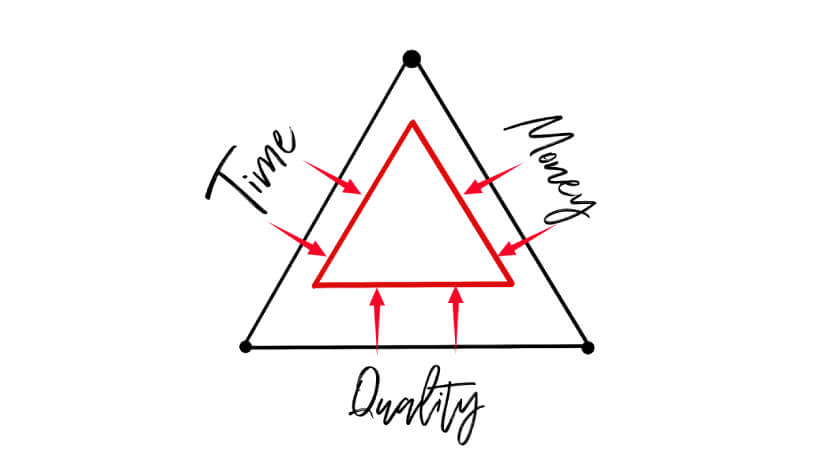Examples of Unsuccessful BI Development, Part II
Table of contents
Time. Money. Quality.
This article clarifies and extends the issues we raised in our previous article. Here, we analyze a situation in which a BI product is launched, but does not deliver the intended results. We will discuss the common reasons why this happens, as well as methods for handling these conflicts. In the end, you want more than mere development; you want unqualified success.
For clarity, we’ll illustrate the economic aspects of handling this situation on the “manager’s triangle.”
We use an equilateral triangle as the starting point, but we should clarify that the triangle represents an ideal. That is, the state of affairs within your company may not be so evenly distributed. Your balance may not resemble other companies’ balances, and the ratio of Time to Money to Quality may not be perfectly equilateral. Moreover, new events can disrupt prior balances. Yesterday’s equilibrium could change tomorrow; what used to be equilateral may now be isosceles.
Company systems and processes reach a balance. New decisions alter the balance. Thus, the triangle below symbolizes a starting point. The lengths of its sides will differ for all organizations. We depict them equilaterally because it shows the state of organizational harmony to which all should aspire.
In the previous article, we highlighted some of the customer-side impediments to successful BI Development. These included:
- Lack of Knowledge
- Lack of Interest in Development
- Inability to Develop Analytics Systems
- Cutting Corners
- Haste Makes Waste
Now, let’s look at these problems and their solutions from the point of view of the implementation team.
Problem #1. Lack of Knowledge
It doesn’t matter how great the developers who implemented your BI system are. Good functionality must come from good information. Without information about YOUR business and YOUR processes, plus an ambassador who can provide this information, successful BI development will be possible only with massive time and money investments.
To avoid this problem, both the customer and the development team should involve analysts to ensure that all information is accurate and up to date. Involving additional analysts will increase labor and time costs in the short-term. But in the long-term, quality and efficiency will rise.
Another option is to create a knowledge base within the company. Either way, developers like us receive a detailed understanding of your organization. Processes become clearer and more detailed; weak points are revealed and addressed. More information is a plus for any company, so all sides of the triangle increase.

Problem #2. Lack of Interest in Development
In this case, all we can do is help guide the company in the right direction, hoping that its personnel have a desire to learn about the potential benefits of BI development. But desire alone is not always enough.
Perhaps a leader in the company wants to develop BI — how can he or she convince others to feel the same? Spend money and time!
Admittedly, it’s difficult to try and convince people that new processes will make their lives easier. Humans resist change. You can never guarantee that it will lead to an increase in quality, and no one wants another burden on their day-to-day lives. Your job is to prove that, if they heed your advice, their day-to-day lives will become simpler.
In this case, the solution starts at the top. Only a manager with sufficient authority can solve this problem. They do so by analyzing their employees’ work, identifying pain points, and increasing data literacy. Setting a positive example will help you communicate the impact of BI development on their lives, thereby nurturing interest in its development.
Solving this problem can only come by spending time and money. Again, it’s an upfront capital investment for the sake of long-term quality.

Problem #3. Inability to Develop Analytics Systems
At this stage, successful BI development depends on improving what you already have. Spending time and money helps to improve quality. Changes to such projects improve the individual projects and the company as a whole. If you understand the need for BI, have encountered a need for more substantial data, and decided to solve the problem by improving your data, full steam ahead!
Of course, it isn’t always possible to change data immediately and easily. The three magic action words are: VALIDATION, DOCUMENTATION, and CONSOLIDATION.
- Validation — We edit the data. This can either happen manually or automatically. Whichever approach you prefer, the data in the source must be well-organized.
- Documentation — We create guiding documents to make the process clear and transparent in the future.
- Consolidation — We create a single point of truth. You enter data rough and unstructured, and it displays clean, processed, and ready for analytics.
As we wrote in the previous article, this problem is the most likely to produce a successful result. Looking at the triangle, you can see how after a certain time and money investment, we will have improved your current process. If you give up at this stage, you will stagnate, and your efforts to develop BI processes will most likely fail.
So, don’t give up. In our experience, any problem can be resolved if everyone sees it, understands it, wants to resolve it, and is prepared to communicate with other team members in the process.

Problem #4. Cutting Corners
If, hoping to save money, you try to do everything yourself (via your internal IT department), we would recommend the following in order to maintain quality:
- Training — Provide BI training for your IT department. This will help them refine and support your goals to the best of their ability.
- Documentation — As in the above step, keep detailed, clear product documentation. This records successful procedures, and is especially important when people with limited experience provide product support.
- Restrictions — If a third-party company developed the functionality for you, establish usage guidelines to prevent interference with the underlying architecture. You can modify a visual part to build new reports based on existing data, but you should not dig into and change the original architecture.
- Backup Plan — It usually helps to retain 1-2 experts from the initial development team. This is your backup plan. These people understand how the architecture looks and functions. They will train your IT department and guide them down the right path.
Now, let’s summarize the result! This section is called “Cutting Corners” for a reason. Handling things internally saves money. But in order to avoid warping to the triangle, you had to take extra steps. What does that lead to? Additional future costs for training and maintaining a small team, as well as documentation costs. What about time? That increases as well! You spent a lot of time on training, but your IT guys are still juniors. Thus, you could not maintain quality at as high a level. As a result, you get the following distortion:

Problem #5. Haste Makes Waste
It seems like, by working faster, you complete your goals more efficiently. But this is an illusion. By moving too quickly, “crutches” appear and hurt quality. Forcing your employees to work faster means spending less money on wages. It seems like our triangle should look like this:

Well, it may — but only in the short-term. Prohibiting proper work undermines the moral fiber of the development team. This insidious effect is much more dangerous than a simple mistake. A shoddy job means a shaky foundation for the whole system, which is extremely difficult to fix when issues arise later. Not to mention that it is impossible to work on “crutches.” The only possible way to remedy this problem is communication, highlighted by the words: “We warn you about the risk.”
Let us summarize the point “Haste Makes Waste.” Does it really make waste? After all, the above triangle says you’re spending less.
While that’s true, you will soon have to spend a lot of money and time to return quality to the initial level. You will inevitably face problems like solution audit, code refactoring, and optimization. All of these challenges are labor-intensive and can only be fixed by highly qualified specialists. Thus, the triangle changes shape. It goes from “cost and quality reduction” to “additional optimization costs.”
Our verdict: Indeed, haste makes waste.
Time is Money is Quality
Through use of the manager’s triangle, we have demonstrated how different decisions affect the inner balance of a company. When reasonably spent, time and money improve overall quality (meaning either the company as a whole or separate business branches). Irrational use of funds leads at best to unnecessary cost and wasted time, and at worst, to additional decline in quality. In general, it’s safe to say: Investing time and money upfront in a team of experts in the field is the most reliable, balanced way to go.

